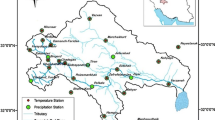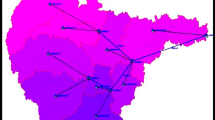Abstract
The spatial interpolation of meteorological data have important applications in ecological environment monitoring, such as soil erosion, ecological vulnerability evaluation. However, there are significant differences in the interpolation accuracy of climatic elements under different topographic and geomorphic conditions. Based on data of 810 meteorological stations across the country, five typical interpolation methods, namely ordinary Kriging method, inverse distance weight method, spline function method, natural neighborhood method and trend surface method, were utilized in this paper to analyze and compare the interpolation accuracy of five climate factors, namely temperature, precipitation, accumulated temperature(>10°),wind speed and sunshine hours, under different topographic and geomorphological conditions. The results showed that: (1) Ordinary kriging method of temperature had better applicability in plain, hill and medium-large undulating mountain areas for temperature while the inverse distance weight method and spline function method had higher interpolation accuracy in the platform area and the small undulating mountain area, respectively. (2) The optimal interpolation of the precipitation in plain, platform and medium-large undulating mountain areas was ordinary kriging method while the inverse distance weight method and spline function method had better applicability in small undulating mountain area. (3) For accumulated temperature (>10 °C), the spline function method had higher interpolation accuracy in plain and platform areas, while ordinary kriging method had better applicability in hilly, small and medium-large undulating mountain area al (4) The optimal spatial interpolation of wind speed in plain and hilly areas was the inverse distance weight method. The natural neighborhood method and the spline function method had the best applicability in plateau, medium-large undulating mountainous areas and small undulating mountain areas, respectively. (5) For sunshine hours, the optimal spatial interpolations in plain and hilly areas were natural neighborhood method and spline function method, respectively, while the ordinary kriging method and the inverse distance weighting method had better applicability in platform, large undulating mountainous areas and small undulating mountainous areas, respectively .








Similar content being viewed by others
References
Bai L, Xu YM, He M, Li M (2017) Remote sensing inversion of near surface temperature based on random Forest. J Geo-Inform Sci 19(03):390–397
Berndt C, Haberlandt U (2018) Spatial interpolation of climate variables in northern Germany—influence of temporal resolution and network density. J Hydrol 15:184–202. https://doi.org/10.1016/j.ejrh.2018.02.002
Boer EPJ, Beurs KMD, Hartkamp AD (2001) Kriging and thin plate splines for mapping climate variables. Int J Appl Earth Observ Geoinform 3(2):146–154. https://doi.org/10.1016/S0303-2434(01)85006-6
Chen ST, Guo B, Zhang R, Zang WQ, Wei CX, Wu HW, Yang X, Zhen XY, Li X, Zhang DF, Han BM, Zhang HL (2021) Quantitatively determine the dominant driving factors of the spatial–temporal changes of vegetation NPP in the Hengduan Mountain area during 2000-2015. J Mountain Sci 18(2):427–445
Fu B, Wang ZL (2013) Relief amplitude study based on digital elevation model. J Jilin Jianzhu Univ 30(06):16–18
Guo B, Wen Y (2019) An optimal monitoring model of desertification in Naiman banner based on feature space utilizing Landsat8 OLI image. IEEE Access 8:4761–4768. https://doi.org/10.1109/ACCESS.2019.2962909
Guo B, Zang WQ, Han BM, Yang F, Luo W, He TL, Fan YW, Yang X, Chen ST (2020a) Dynamic monitoring of desertification in Naiman banner based on feature space models with typical surface parameters derived from Landsat images. Land Degrad Dev 31:1573–1592. https://doi.org/10.1002/ldr.3533
Guo B, Zang WQ, Luo W (2020b) Spatial-temporal shifts of ecological vulnerability of Karst Mountain ecosystem-impacts of global change and anthropogenic interference. Sci Total Environ 74:140256. https://doi.org/10.1016/j.scitotenv.2020.140256
Guo B, Zang WQ, Luo W, Wen Y, Yang F, Han BM, Fan YW, Chen X, Qi Z, Wang Z, Chen ST, Yang X (2020d) Detection model of soil salinization information in the Yellow River Delta based on feature space models with typical surface parameters derived from Landsat8 OLI image. Geomat Nat Haz and Risk 11(1):288–300. https://doi.org/10.1080/19475705.2020.1721573
Guo B, Zang WQ, Yang F, Han BM, Chen ST, Liu Y, Yang X, He TL, Chen X, Liu CT, Gong R (2020) Spatial and temporal change patterns of net primary productivity and its response to climate change in the Qinghai–Tibet plateau of China from 2000 to 2015. J Arid Land 12(1):1–17
Guo B, Zang WQ, Zhang R (2020c) Soil Salizanation information in the Yellow River Delta based on feature surface models using Landsat 8 OLI data. IEEE Access 8(1):94394–94403. https://doi.org/10.1109/ACCESS.2020.2995458
Hancock PA, Hutchinson MF (2005) Spatial interpolation of large climate data sets using bivariate thin plate smoothing splines. Environ Model Softw 21(12):1684–1694. https://doi.org/10.1016/j.envsoft.2005.08.005
Hasenauer H, Merganicova K, Petritsch R, Pietsch SA, Thornton PE (2003) Validating daily climate interpolations over complex terrain in Austria. Agric For Meteorol 119(1–2):87–107. https://doi.org/10.1016/S0168-1923(03)00114-X
James OB, Victor DO, Bruno S (2001) Objective Bayesian analysis of spatially correlated data. J Am Stat Assoc 96(456):1361–1374. https://doi.org/10.1198/016214501753382282
Jeffrey SJ, Carter JO, Moodie KB, Beswick AR (2001) Using spatial interpolation to construct a comprehensive archive of Australian climate data. Environ Model Softw 16(4):309–330. https://doi.org/10.1016/S1364-8152(01)00008-1
Li GC, Dai WJ, Zeng FH, Liu B (2016) Application of Three-Dimensional Dynamic Trend Surface Fitting Model on Land Subsidence. J Geodesy Geodynamics 36(06):508–512. https://doi.org/10.14075/j.jgg.2016.06.009
Liao SB, Li ZH, You SC (2003) Comparison on methods for rasterization of temperature data. Resources Sci 25(06):83–88
Liao SB, Zhang S (2014) Scale effect of errors on Spatialization of annual mean temperature data. J Geo-Inform Sci 16(01):8–14
Liu YW, Lai GY, Chen YZ, Huang L (2007) A research on rainfall spatial interpolation methods based on GIS. J Subtrop Resourc Environ (03):29–34. https://doi.org/10.19687/j.cnki.1673-7105.2007.03.005
Nalder IA, Wein RW (1998) Spatial interpolation of climatic Normals: test of a new method in the Canadian boreal forest. Agric For Meteorol 92(4):211–225. https://doi.org/10.1016/S0168-1923(98)00102-6
Skirvin SM, Marsh SE, McClaran MP, Meko DM (2002) Climate spatial variability and data resolution in a semi-arid watershed, South-Eastern Arizona. J Arid Environ 54(4):667–686. https://doi.org/10.1006/jare.2002.1086
Tang GA, Yang WY, Yang X, Liu AL, Yi HW, Li XY (2003) Some key points in terrain variables deriving from DEMs. Sci Surveying Mapping 28(01):28–32
Tang LN, Su XD, Shao GF, Zhang H, Zhao JZ (2012) A clustering-assisted regression (CAR) approach for developing spatial climate data sets in China. Environ Model Softw 38:122–128. https://doi.org/10.1016/j.envsoft.2012.05.008
Tu HM, Liu ZD (1990) Demonstration of the best statistical unit of topography in China. J Hubei Univ 12(03):266–271 CNKI:SUN:HDZK.0.1990-03-016
Wang BB, Shi LH, Lu YM (2018) A space-time reverse distance weighted interpolation method considering elevation. Geomatics Spatial Inform Technol 41(10):82–85
Wang C, Jiang L, Xu J, Yang CC (2014) Accuracy differences among approaches of DEM surface morphology reconstruction. Geography Geo-Information Sci 30(04):18–21
Wang L, Tong XJ (2007) Analysis on relief amplitude based on change point method. Geography Geo-Inform Sci 23(06):65–67
Yang XL, Zhang KB, Cao YX, Wang HX (2009) Plant diversity in the process of vegetation restoration in Yanchi County of Ningxia Hui nationality autonomous region. Bull Soil Water Conserv 29(06):163–167. https://doi.org/10.13961/j.cnki.stbctb.2009.06.010
Zhang XP, Zhang C, Wang SD (2014) Quantitative analysis of interpolation DEM accuracy in plain area. Geospatial Inform 12(04):75–77
Zhou TT, Chen WH (2011) Comparison of temperature spatial interpolation methods based on MODIS data and meteorological observation data. Adv Geograph Sci 30(09):1143–1151
Zhu HC, Chen N, Liu HY, Tang GA (2005) Extraction of topographic undulations from DEM on a scale of 1: 10000 —taking the experiment on the loess plateau in northern Shaanxi as an example. Sci Survey Mapping 30(04):86–88
Acknowledgments
This work was supported by the Open fund of Key Laboratory of National Geographic Census and Monitoring, MNR (grant no.2020NGCM02);Open Research Fund of the Key Laboratory of Digital Earth Science, Chinese Academy of Sciences (grant no. 2019LDE006); the Open Fund of Key Laboratory of Urban Land Resources Monitoring and Simulation, Ministry of Natural Resources (grant no. KF-2020-05-001);Open fund of Key Laboratory of Land use, Ministry of Natural Resources (grant no.20201511835); Open Fund of Key Laboratory for Digital Land and Resources of Jiangxi Province, East China University of Technology (grant no. DLLJ202002); Open foundation of MOE Key Laboratory of Western China’s Environmental Systems, Lanzhou University and the fundamental Research funds for the Central Universities (grant no. lzujbky-2020-kb01); University-Industry Collaborative Education Program (grant no.201902208005); Open Fund of Key Laboratory of Meteorology and Ecological Environment of Hebei Province (grant no.Z202001H); Open Fund of Key Laboratory of Geomatics and Digital Technology of Shandong Province; Open Fund of Key Laboratory of Geomatics Technology and Application Key Laboratory of Qinghai Province (grant no. QHDX-2019-04).
Author information
Authors and Affiliations
Corresponding author
Additional information
Communicated by: H. Babaie
Publisher’s note
Springer Nature remains neutral with regard to jurisdictional claims in published maps and institutional affiliations.
Rights and permissions
About this article
Cite this article
Guo, B., Yang, F., Wu, H. et al. How the variations of terrain factors affect the optimal interpolation methods for multiple types of climatic elements?. Earth Sci Inform 14, 1021–1032 (2021). https://doi.org/10.1007/s12145-021-00609-2
Received:
Accepted:
Published:
Issue Date:
DOI: https://doi.org/10.1007/s12145-021-00609-2




